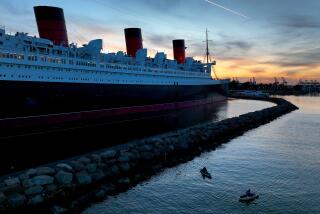BRITAIN : Finances May Sink the Royal Yacht : The Britannia was used just 31 days in 1991 at a cost of $18 million.
- Share via
LONDON — One of the grander jewels in the British crown has been its ship of state, the royal yacht Britannia.
But the aging and increasingly expensive Britannia is in danger of being retired from duty after 40 years of service, a career in which the 5,700-ton, 375-foot vessel showed the British flag around the world.
Just this week, the Ministry of Defense said the Britannia would no longer be expected to serve as a hospital ship in time of national crisis. And the ministry acknowledged that the future of Britannia and its crew of 270 is “under review.”
The Britannia, launched in 1953, was conceived as both a floating palace for the Royal Family and, when needed, a hospital ship; and it was these dual functions that induced the budget-minded Labor Party government of that time to approve its construction.
But during the 1982 war to recapture the Falkland Islands from Argentina, the Britannia was deemed unsuitable, and a cruise liner, the Uganda, was chartered as a hospital ship instead. The royal yacht has never carried wounded troops.
A few weeks ago, Prince Philip, husband of Queen Elizabeth II, announced that he would use the Britannia this month on an official visit to the Caribbean with a stopover in Florida--at an estimated cost of $7.5 million for two weeks.
That news provoked charges of royal extravagance from Labor members of Parliament. They pointed out that the Britannia is the most expensive item in the royal travel budget, costing close to $18 million a year for its upkeep. In 1991, they noted, the ship was used by the Royal Family only 31 days.
In contrast, the royal train costs less than $4 million a year, while the heavily used Queen’s Flight of helicopters and passenger jets runs up an annual bill of around $11 million.
Arguing that the ship should be retired as soon as possible, Labor member of Parliament Alan Williams termed it “a geriatric waste of money.”
The Britannia is the second-oldest ship on the Royal Navy’s active list, after Adm. Horatio Nelson’s 18th-Century flagship Victory, now a floating museum at Portsmouth.
When the Britannia was commissioned, the Times of London welcomed it, saying it had been unseemly for the head of the British Empire to charter an ocean liner when the monarch had occasion to go “afloat in state.”
Over the years, about $150 million was spent on various remodelings, the latest only last year. Britannia’s mahogany and brass fittings are relatively modest compared to those aboard tycoons’ yachts, although the vessel has a dining room that can seat 100. In addition, it carries the 41-foot royal barge, two medium-speed motor boats, other fast motor dinghies and two 14-foot sailing dinghies, along with a Range Rover and Rolls-Royce.
The ship can carry a 26-member contingent of the Royal Marines band to serenade foreign dignitaries.
A typical mission for the Britannia is to steam to a foreign port to await the arrival by air of a member of the Royal Family, then to serve as a site for ceremonial dinners and to take short cruises.
The Britannia has also been used occasionally to entertain foreign businessmen on “Sea Days,” short cruises meant to drum up foreign investments and markets for British exports.
The closest the yacht came to acting as a hospital ship was in 1984 when, sailing past South Yemen en route to Australia, its crew picked up refugees after an outbreak of civil strife. During the Persian Gulf War, the Britannia was awaiting a royal visit in South America--too far from the conflict to take part.
In 1661, King Charles II was the first British monarch to have a royal yacht. Elizabeth II may be the last.
As Phillip Hall, author of “Royal Fortune: Tax, Money and the Monarchy,” put it: “The royal yacht is used only as a floating hotel. The hospital ship option has finally run aground. The idea that Britannia is vital to Britain’s export drive is equally hard to keep afloat. No convincing argument for a new yacht may well mean no new yacht.”
More to Read
Sign up for Essential California
The most important California stories and recommendations in your inbox every morning.
You may occasionally receive promotional content from the Los Angeles Times.













